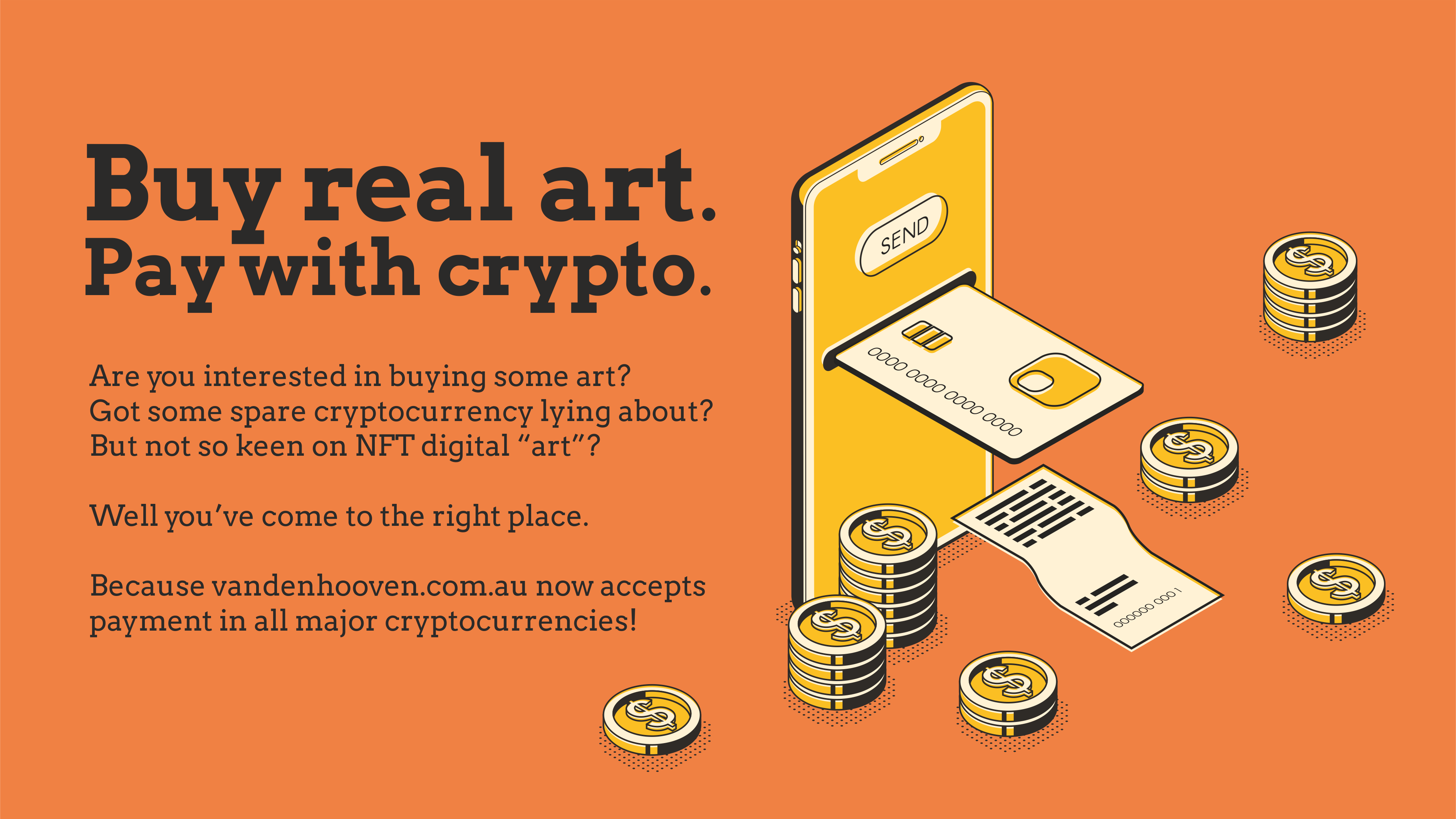
How can I use bitcoin and other cryptocurrencies to buy real art?
We now accept Bitcoin or other cryptocurrencies to pay for our art, yes.
This is a somewhat reluctant move, and we admit that still prefer other more traditional payment methods.
However in the interest of encouraging new orders and lowering barrier to entry for new and established art collectors alike, we recently decided to accept Bitcoin and other cryptocurrencies via our online store.
Please select the “Coinbase” payment gateway at the time of your checkout. From there click the “proceed to coinbase”button to finalise the art transaction.
These are the reasons we still prefer other payment methods:
Look, we’re not against a decentralising currrency economy per sé. It’s just that we don’t think this new “blockchain” technology is the way to go about it…
The trouble with Bitcoin, Litecoin, Ethereum, Binance, Dogecoin and all these new other what we’d call “cowboy cryptocurrencies” is that they are prodigiously energy intensive. There’s no getting around that.
To verify transactions, Bitcoin requires computers to solve ever more complex math problems. In the case of Bitcoin, this is done by having many different competitors (miners) all conduct a race to see how quickly they can solve a small mathematical equation.
When bitcoins are traded, computers across the globe race to complete a computation that creates a 64-digit hexadecimal number, or hash, for that bitcoin.
The one who completes the mathematical equation the fastest not only certifies the transaction but also gets a small reward for their trouble in the form of a Bitcoin payment. This is inherently wasteful in the sense that 99.99% of all the machines that did work just throw away the result.
Earlier in bitcoin’s relatively short history, one could mine bitcoin on an average computer. But the way bitcoin mining has been set up by its creator is that there is a finite number of bitcoins that can be mined: 21 million. The more bitcoin that is mined, the harder the algorithms that must be solved to get a bitcoin become.
Now that over 18.5m bitcoin have already been mined, the average computer can no longer mine bitcoins. Instead, mining now requires special computer equipment that can handle the intense processing power needed to get bitcoin today. And, of course, these special computers need a lot of electricity to run.
Thus, Bitcoin alone is estimated to consume 127 terawatt-hours (TWh) a year. That usage exceeds the entire annual electricity consumption of Norway. Or Argentina.
Of that, it is estimated that one bitcoin transaction takes 1,449 kWh to complete, or the equivalent of approximately 50 days of power for the average US household.
To put that into money terms, the average cost per kWh in the US is close to 12 cents. That means that a single bitcoin transaction would generate an energy bill of approximately $173.
Today, data mining happens in vast data centers owned by companies or collectives. Operations have already consolidated so much that now only seven mining groups own nearly 80% of all computing power on the network. But wasn’t the whole idea of crypto to democratise currency?
We think it’s an extremely energy inefficient and wasteful of resources. So we won’t be accepting any crytpo payments any time soon.
Cryptocurrency risks:
- Cryptocurrency payments do not come with legal protections.
Credit cards and debit cards have legal protections if something goes wrong. For example, if you need to dispute a purchase, your credit card company has a process to help you get your money back. Cryptocurrencies typically do not come with any such protections. - Cryptocurrency payments typically are not reversible.
Once you pay with cryptocurrency, you can usually only get your money back if the person you paid sends it back. Before you buy something with cryptocurrency, know the seller’s reputation, by doing some research before you pay. - Some information about your transactions will likely be public.
People talk about cryptocurrency transactions as anonymous. But the truth is not that simple. Cryptocurrency transactions will typically be recorded on a public ledger, called a “blockchain.” That’s a public list of every cryptocurrency transaction — both on the payment and receipt sides. Depending on the blockchain, the information added to the blockchain can include details like the transaction amount, as well as the sender’s and recipient’s wallet addresses. It’s sometimes possible to use transaction and wallet information to identify the people involved in a specific transaction. And when you buy something from a seller who collects other information about you, like a shipping address, that information can also be used to identify you later on. - Crypto is largely not regulated.
Many crypto-assets and other digital assets are not commonly considered to be financial products. Because of this, the platform where you buy and sell crypto may not be regulated by local governments (that’s generally half the point of crypto). So you may not be protected if the platform fails or is hacked.When a crypto-asset fails, you will most likely lose all the money you put in. In most countries, crypto is not legal tender. You’re only protected to the extent that crypto fits within existing laws. - Volatility.
Cryptocurrency prices can often fluctuate. While this volatility can lead to quick profits, it can also cause significant financial losses for investors under certain circumstances, such as when the price of cryptocurrency dips suddenly.


